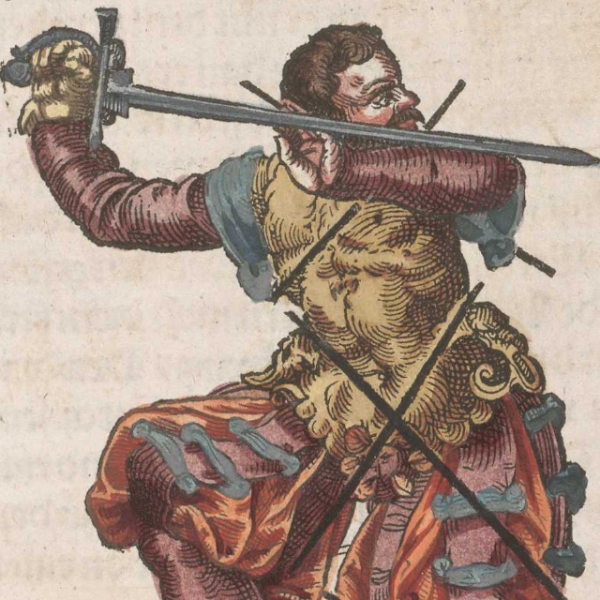
We’re creating several versions of Joachim Meyer’s 1570, including a free, professional translation!
Indiegogo functionality notes:
- To view the perk description, click the box once. To buy, click twice.
- Unlike with Kickstarter, you can’t upgrade perks. If you’d like to select multiple perks, just check out multiple times and select a different perk each time.
- If you’re planning a large group order, contact me and we can discuss bulk discounts and combined shipping.
- In order to keep up with the tumultuous price shifts of the current shipping market, I won’t be collecting shipping fees until the books are printed and ready to mail.
tl;dr
We’re crowdfunding a new translation of Meyer 1570 by a professional German translator, and it will be free to use for the whole community when it’s done. We’re selling ebooks and physical copies to cover the costs, and also producing a full facsimile of the painted Meyer. Book options include:
- Just the translation (hardcover, softcover, or ebook)
- Transcription and translation side-by-side (hardcover or softcover)
- Separate book of illustrations in color and B&W (hardcover or softcover)
- Detailed facsimile
- Prestige edition (translation laid out like the original book and constructed like the facsimile)
Background
My name is Michael Chidester. I started HEMA in 2001, and since 2010 I’ve been leading a project called Wiktenauer. Wiktenauer grew out of a desire to set the text of our fencing manuals free from the page and put it into the hands of fencers. In 2019, I started a venture called HEMA Bookshelf with a different objective: to put the page, and the whole book, into your hands as well. To date, we’ve produced three gorgeous facsimiles of 15th century manuscripts.
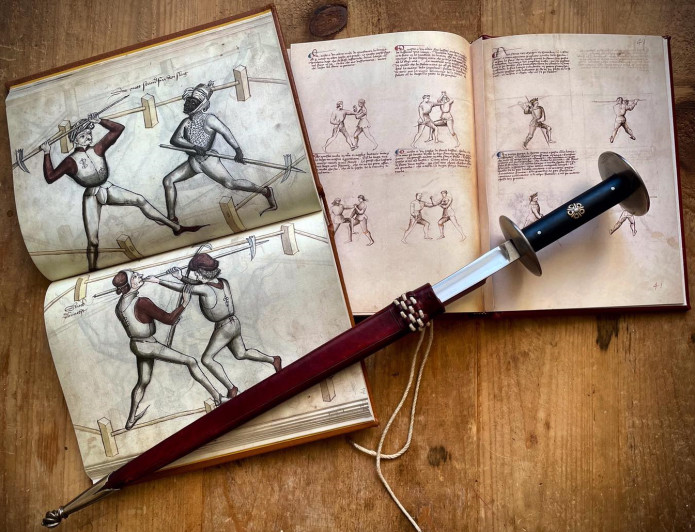
Fiore and Talhoffer facsimiles (Photo cred: David Rawlings)
This project is the first joint venture between these two projects: we’re going to produce a a complete, professional translation of Joachim Meyer‘s famous printed treatise of 1570.
Meyer is by far the longest of the early German treatises, and is the most popular 16th century source in HEMA. But getting an English version has been harder than it sounds. The first Meyer translation project was launched by Mark Rector in early 2000, but he only got as far as a partial transcription. Mike Rasmusson picked up the torch in 2002 and put a partial translation of the sword section on Schielhau.org, but he never continued either. (This is the translation currently on Wiktenauer.) This inspired Jeffrey Forgeng to try his hand, and he authored a complete translation in 2003, ultimately publishing it in 2006. This book was hugely popular, but within five years the entire print run sold out and it became impossible to get. When a second edition finally came out in 2015, it likewise sold out within a few years.
But even if Dr. Forgeng’s translation were easy to get forever, what we really need in order to grow the community is a translation that’s free for everyone to read and practice from, and also to edit and remix and post on Facebook and quote in YouTube videos, all without the worrying about copyright.
So that’s what we’re going to make.
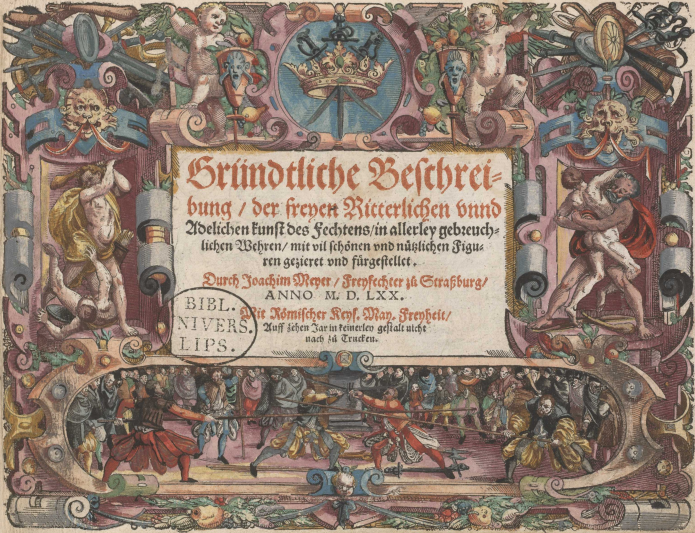
Title page from the University of Leipzig copy
What We Need & What You Get
I’ve hired Dr. Rebecca Garber to author the new translation. She has previously worked with HEMA Bookshelf on the Talhoffer Companion Volume, and a longer biography is below. She’s already halfway through the book, currently working through the rapier section, and we’ve been running her translations past various Meyer scholars and instructors for feedback once she finishes them.
In addition to Dr. Garber’s translation, I’ve spent the first half of the year slowly transcribing the entire book, and you can now find this transcription on Wiktenauer.
Meyer’s book is incredibly long, so creating this translation will cost $12,000. On top of that, we need to pay for editing, layout, printing costs, advertising, and so forth. That’s why we’re coming to you.
To cover this bill, we will be selling the new transcription and translation in a variety of formats. These books will also include a lengthy introduction and historical background contributed by Chris Vanslambrouck, captain of the Meyer Freifechter Guild, and Roger Norling, Editor-in-Chief of HROARR.
The Reading Edition (translation only)
This will be a smaller format sized to carry around and be comfortable to hold in one hand (royal quarto, 6.14 x 9.21 in). It will contain the translation along with black and white illustrations. This comes in ePub, softcover, and hardcover.
The Study Edition/Dual-Language Edition (transcription and translation)
This will be a larger format, either A4 or 8.5 x 11 in. It will consist of a two-column setup with the transcription and translation side-by-size. It will not include illustrations (or if it does, only small black and white ones at the back), but will be designed as part of a 2-volume set with the illustration book.
The Visual Reference (illustrations only)
This will include all 69 of Tobias Stimmer’s original prints at their original size, and also the full set of painted prints from the University of Leipzig’s copy at 150% of their original size. Alongside these illustrations will be tables indicating all of the references to each one in the text, including the page numbers in Meyer’s book, the Reading and Study Editions, and Dr. Jeffrey Forgeng’s 2006 translation, as well as the name of the play or description of the action. (This will be substantially similar to The Illustrated Meyer, so you can buy the Study Edition separately if you already own that.)
A New Facsimile
HEMA Bookshelf has promised and delivered quality replicas of historical manuscripts at affordable prices. To support this project, we’re going to produce our first facsimile of a printed book: Joachim Meyer’s Gründtliche Beschreibung der… Kunst des Fechtens. There are 28 known copies of this book, and the one we’re reproducing is the gorgeous Leipzig University copy, including its original hand-painted, full-color illustrations and 16th century binding.
In addition to using the high-resolution scans of this copy as a basis, I will be visiting the Metropolitan Museum of Art on New York to consult their copy of the 1570 and study its construction in order to create the best replica possible. (Details of other copies found during the ongoing Meyer Location Project may also sneak in.)
This facsimile will be our longest yet (460 pages), with every detail as close to the original as possible. That includes blind-tooled leather covers reproducing the design of Leipzig copy, including Lucretia and Justitia, and the pages reproduced in every detail on cotton rag pape in the correct quire structure. The result will have the look and feel of an actual historical artifact.
The Prestige Edition (translation only)
If facsimiles aren’t your thing, we’re trying something brand new with this project. Since Meyer is ultimately a printed book, we’re going to take Dr. Garber’s translation, lay it out page-by-page the same way Thiebolt Berger did in 1570, and then print it and bind it using the same materials and methods as the facsimile. We’ll also include the painted Leipzig illustrations, of course. The result will be the most gorgeous HEMA translation you’ll ever own.
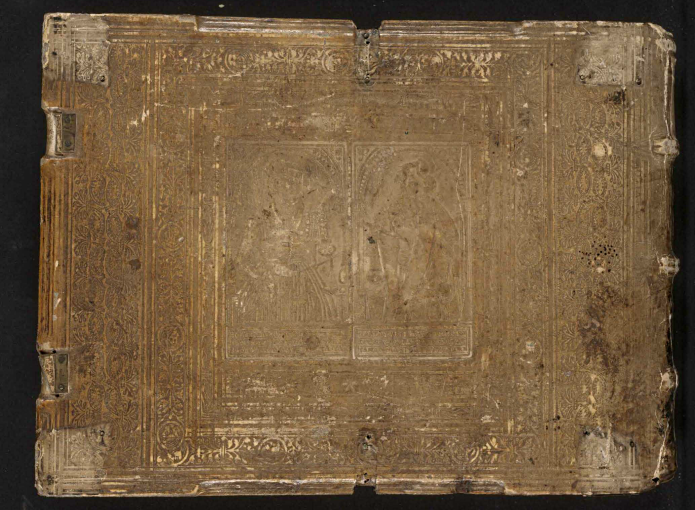
The rear cover to the University of Leipzig copy.
The Impact
This project has two objectives. One is obviously to publish new books and to add something beautiful to the world that didn’t exist before. That’s the reason HEMA Bookshelf exists in the first place.
The other is to create a translation and then give it away. It will be posted on Wiktenauer in its entirety under a Creative Commons Attribution-ShareAlike license. This means you’ll be able to use it however you want to, forever (as long as you credit Dr. Garber and Wiktenauer, and as long as you make no claims of copyright over it). You’ll be able to distribute it to your students (or your teachers), and you’ll even be able to publish your own version of it if you want to.
At Wiktenauer, our guiding philosophy is that the treatises belong to all of us. They’re part of our cultural heritage as humans and the foundation of everything we do in HEMA. We respect the copyrights of others but ultimately, Wiktenauer’s main mission is to give the treatises away for free. This project will help us further that goal.
If people we don’t know and have never met are able to study Meyer because they stumbled onto this translation, then Wiktenauer will have succeeded at its mission.
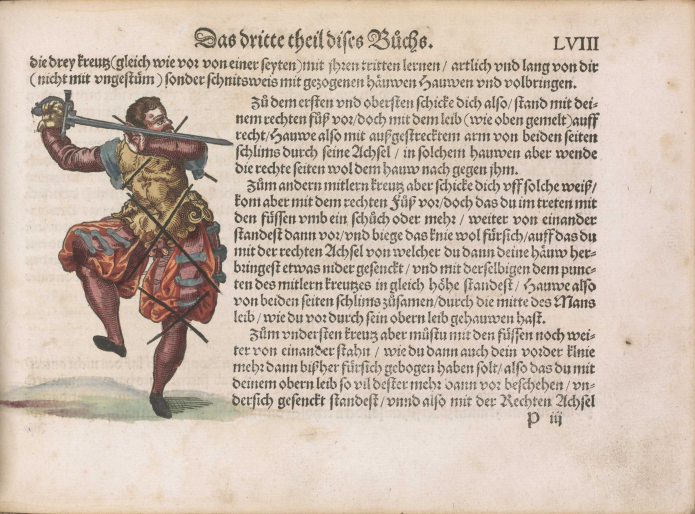
Text and illustration from the University of Leipzig copy.
Risks & Challenges
The risks of this project are minimal. HEMA Bookshelf has published three facsimiles and four conventional books at this point and we know the ropes. We’re not trying anything particularly different with these, so the main risk is the ever-looming threat of covid-related shutdowns, which have caused months of delays in past projects.
The challenge we face is raising enough money to pay for the translation and editing. In order to keep prices down, our margins on the books and facsimiles are never as large as most publishers expect, but if we sell about as many as in past projects we should be okay.
Other Ways You Can Help
If you can’t contribute to this project, please spread the word anyway. We received about 400 orders each for the Talhoffer and Fiore facsimiles, and about 275 for Lecküchner, so let’s see if there are at least that many Meyer enthusiasts out there!
Please share this campaign with your clubs, with your friends, and on social media!
About the Translator
Rebecca L. R. Garber received her PhD in German Languages and Literatures from the University of Michigan in 1999, with a specialization in Medieval Studies. She taught for 3 years at Wayne State University and then at a private high school before turning to translation as a full-time occupation. After joining a stage combat troupe in Michigan in 2006, she began translating combat manuals with CHEMAS (the Cambridge HEMA Study group), where her expertise in Medieval German and Latin was more useful than in most aspects of modern life. Her previous published HEMA translations include “Florius de Arte Luctandi” (with Kendra Brown) in The Flower of Battle of Master Fiore Furlano de’I Liberi, and the Copenhagen Talhoffer manuscript in Alte Armatur und Ringkunst, the companion volume to HEMA Bookshelf’s facsimile. These translations can also be found on Wiktenauer. She has also worked on MS I.33, Codex Wallerstein, Paulus Hector Mair, and Jörg Wilhalm for private use.

